|
WATERTIGHT
CYLINDER (WTC) - An Overview
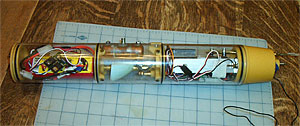 |
1.
The heart of any radio controlled submarine is the
watertight cylinder, or WTC. Whether you choose to build
your own or buy a custom unit, the basic elements remain
the same. As previously noted, the optimum size for the
Permit hull is a 3" diameter cylinder.
The D&E Miniatures WTC-3 depicted here consists of
three compartments: battery, ballast tank and propulsion
(l-r). |
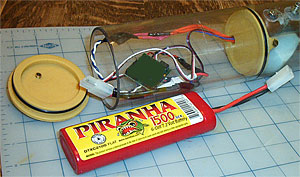 |
2.
The Battery Compartment is accessed through a removable
forward bulkhead. Inside is the battery, usually a 6
cell NiCad pack. It is connected to the electronic speed
control, in this case a ThorDesign
SC-10 Speed Control. The SC-10 is then connected
to the motor by wires which run through a watertight
tube passing through the adjacent Ballast Tank to the
aft dry space. It is recommended that a fuse be installed
in-line between the battery and motor. A second lead
runs from the SC-10 to the receiver in the aft compartment.
This supplies power for the electronics via the SC-10's
built-in battery eliminator circuit (BEC).
|
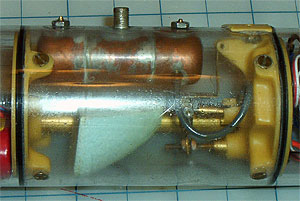 |
3.
Located between the Battery and Propulsion compartment
is the Ballast Tank. The system pictured features a copper
bottle which is charged with a compressed gas (Propel)
which is used to purge water from the tank. The tank's
bottom is open to allow free flooding and draining. At
the top is a valve which opens to vent the tank. A servo
mounted on the dry side of the aft bulkhead operates both
the vent and blow valves. The blue-white foam object in
the tank is a float which monitors the water level and
prevents excess blowing of gas when the tank is dry. |
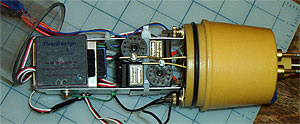 |
4.
The Propulsion Compartment is accessed through a removable
rear bulkhead. Mounted in the bulkhead is the electric
motor and reduction gear. A 3:1 reduction works well for
a 1/96 Permit class boat. Reduction gears reduce
the work load on the motor and thus extends the run time
for the battery. The radio receiver is mounted on the
underside of the electronics rack attached to the removable
bulkhead. |
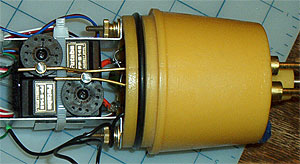 |
5.
The receiver processes the radio signals and sends commands
to the servos. Two servos are connected to the linkages
for the rudder and stern planes. Their control rods
pass through the stern bulkhead using watertight seals.
|
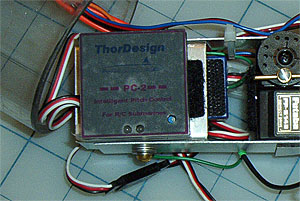 |
6.
An essential piece of electronics is the angle keeper.
It is mounted between the receiver and the stern plane
servo. The most advanced unit of its kind is the ThorDesign
PC-2A
Pitch Control. Using an accelerometer, the
PC-2 senses the boat's attitude and sends corrective
action to the stern planes to keep a zero bubble. It
is essential that PC-2 be mounted level in the WTC.
|
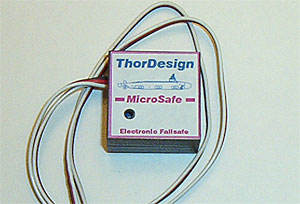 |
7.
Another in-line device is MicroSafe,
a micro-sized failsafe. MicroSafe is connected between
the ballast tank blow servo and the receiver. It constantly
monitors the radio signal being received. In the event
the signal is lost, it automatically commands a blow of
the ballast tank, following a preset delay of several
seconds, and the boat surfaces. Never operate submerged
without a MicroSafe. |
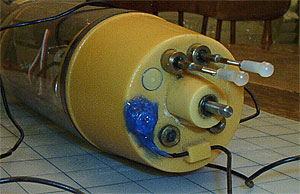 |
8.
Here the stern bulkhead exterior can clearly be seen.
The receiver antenna exits the bulkhead and it's connector
is covered in silicone to ensure watertightness. The
antenna is looped within the wet area of the hull. The
watertight seals for the drive shaft (centered) and
two control shafts can also be seen. With the WTC and
drive train installed, the next step in assembly is
connecting the model's control surfaces to their servos...
|
| |
Linkages
|
|
|
Details,
Details
Most
manufacturers of WTC's, such as D&E Miniatures,
include a setup and operations manual with their units.
The information given here is intended as a supplement,
not a replacement, for those specific manufacturer instructions.
|
|
A
Word To The Wise
Never
use a lead acid or "gel cell" type battery
in a dry WTC compartment. Gel cells can give off hydrogen
gas under normal operating loads or when charging. If
this highly flammable gas comes in contact with a spark
generated by the motor or other electronic device, the
results can be catastrophic. Always use a NiCad or NiMH
type battery pack in enclosed WTC compartments.
|
|



